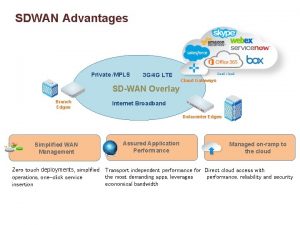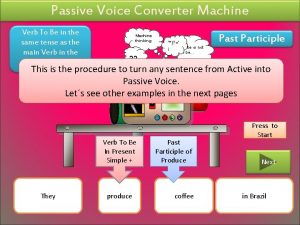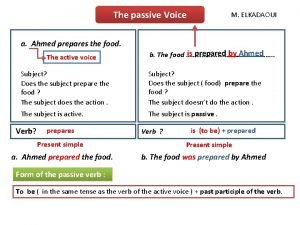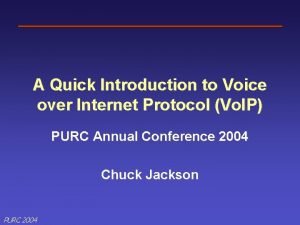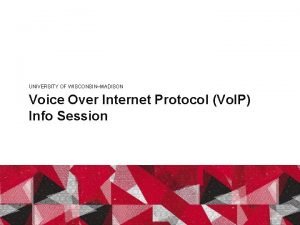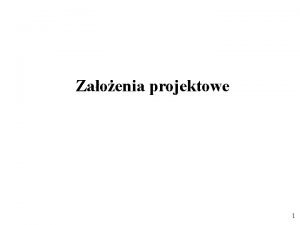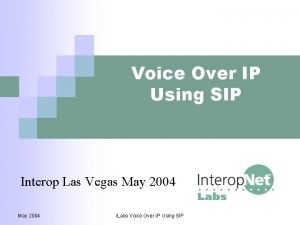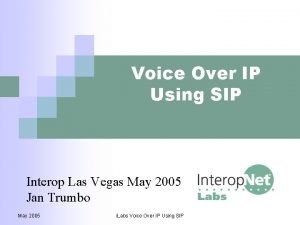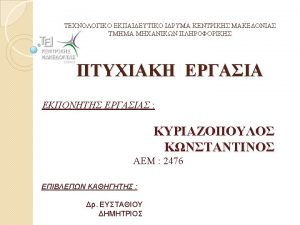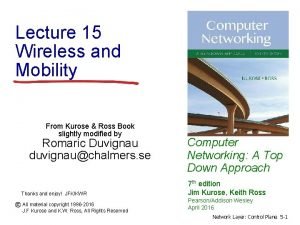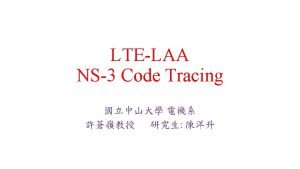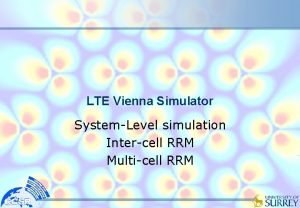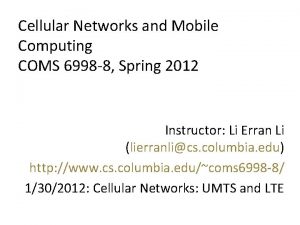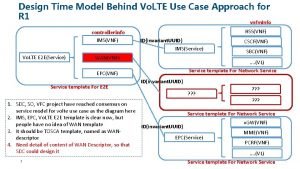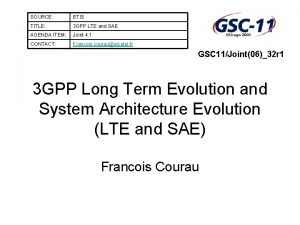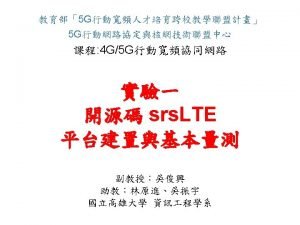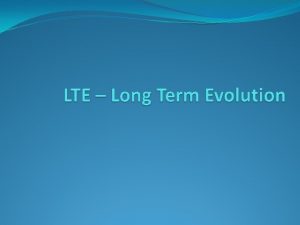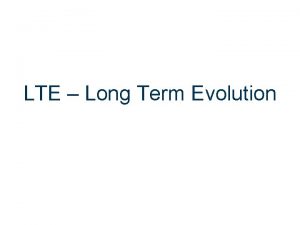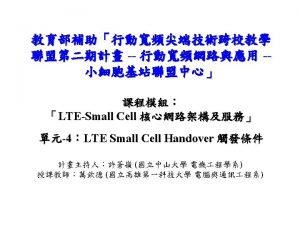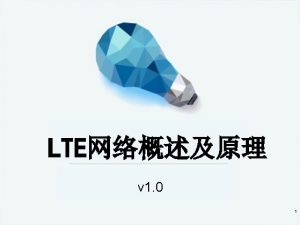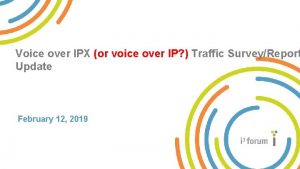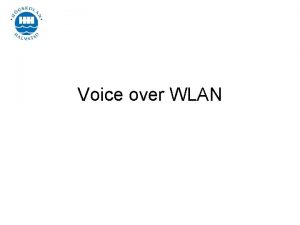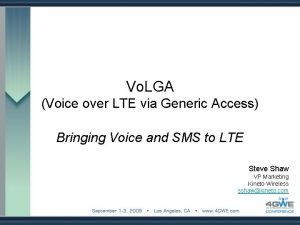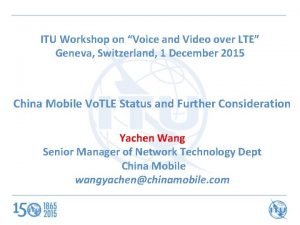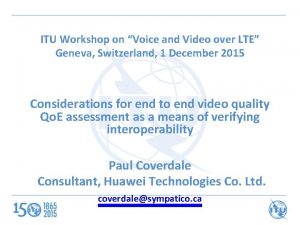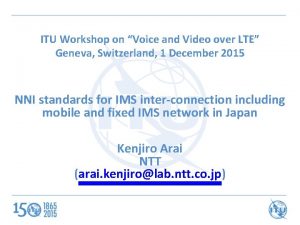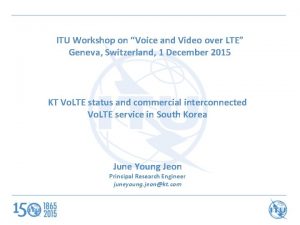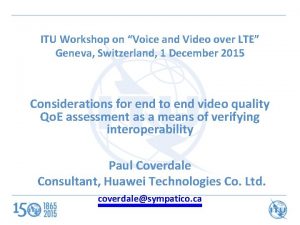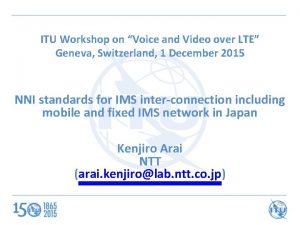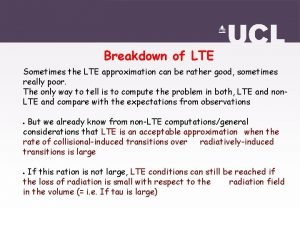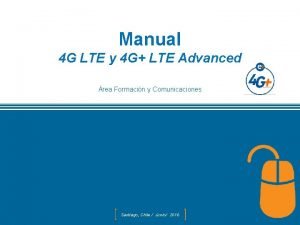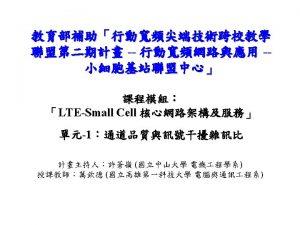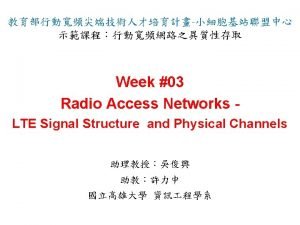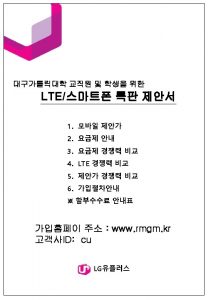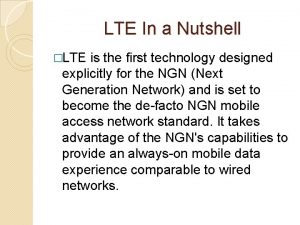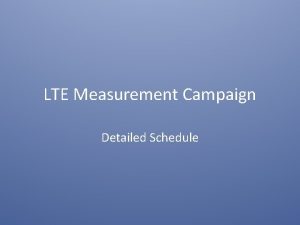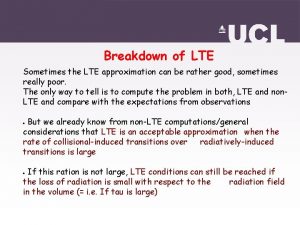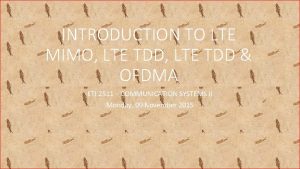Vo LTE Voice over LTE 2011 07 15


























- Slides: 26

Vo. LTE (Voice over LTE) 2011. 07. 15 Sung. Hoon Jung: sunghoon. jung@lge. com Copyright Notification . No part may be reproduced except as authorized by written permission. The copyright and the foregoing restriction extend to reproduction in all media. ⓒ 2011. LG 3 GPP RAN 2 team. All rights reserved. LG Electronics RAN 2 Team

List of Contents Challenges for Voice Service in LTE network GSMA Vo. LTE Initiative Voice Service Solutions for LTE IMS Voice over PS Handover Circuit Switch Fallback § § § Network Architecture for CSFB MO Call Flow CSFB MT Call Sequence Combined Mobility Management for CSFB Enhancement Single Radio Voice Call Continuity § Network Architecture for SRVCC § SRVCC Message Flow Domain Selection between IMS and CS Evolution Path towards Voice over LTE RAN Optimizations for Voice Service LG Electronics RAN 2 Team

Challenges for Voice Service in LTE network Migration of voice service domain Traditionally voice was implemented over CS domain LTE is a pure IP network Non-uniform solutions proposed for voice support CSFB, Vo. LGA, ‘One Voice’ The risk of industry fragmentation Diverse implementations >> Complexity increase >> Roaming restricted >> Loss of economies of scale Industry agreement is definitely needed LG Electronics RAN 2 Team

GSMA Vo. LTE Initiative GSMA selects ‘One Voice Profile of IMS SIP’ for voice service and SMS Formally announced on 15 th Feb. 2010 SGMA Mobile World Congress Massive support from many operators(>40) and vendors Work scope One Voice work + end-to-end voice and SMS ecosystem § One Voice profile: Minimum mandatory set of features for interoperable, high quality IMS-based telephony service over LTE radio access Mobile Device Radio Access Network IMS basic capabilities and supplementary services for telephony Real-time media negotiation, transport, and codecs LTE radio and evolved packet core capabilities Functionality that is relevant across the protocol stack and subsystems Server (IMS) § Roaming and interconnect interfaces also included as work scope Technologies Based on 3 GPP IMS specifications SRVCC for voice call continuity when moving out of LTE coverage LG Electronics RAN 2 Team

Voice Service Solutions for LTE Voice over CS Circuit Switch Fallback (CSFB) § Existing CS domain of 2 G/3 G is used for voice service § Considered as an Interim solution Voice over PS OTT (over the top) § § Application over IP, e. g. , Skype, My. People (DAUM. net), Google. Talk Smart phones over mobile broadband unsatisfactory Qo. S Operators’ bar IMS voice § § Standard solution supported by operators End-to-end Qo. S is guaranteed regulatory regime can be supported Easy incorporation of multi-media richness along with network evolution Other Vo. LGA § Enable voice service by adopting UMA/GAN for LTE, and reusing SRVCC mechanism for handover from LTE to 2 G/3 G CS LG Electronics RAN 2 Team

IMS Voice over PS Principle MMTel-based IMS voice service § Rich multimedia service promised once deployed All IP-based network should be deployed throughout the service coverage § Full coverage of LTE; or § Partial LTE coverage complemented by HSPA LTE EPC IMS MMTel Vo. IP bearer E-UTRAN IMS voice over PS (e. g. , LTE) Terms MMTel IMS Multi-Media Telephony IP Multimedia Subsystem LG Electronics RAN 2 Team

PS Handover Principle § LTE Vo. IP bearer is handed over to 3 G PS Vo. IP bearer § IMS voice service is continued after handover Handover preparation E-UTRAN LTE r are IP Vo be EPC PS HO Vo IP be are S 3, S 4 IMS MMTel IMS voice 3 G PS core r HSPA UTRAN PS Handover LG Electronics RAN 2 Team

Circuit Switch Fallback Principle § LTE UE is directed to 2/3 G CS domain when voice call needs to be initiated § Existing CS call support mechanism used (i. e. , non-IMS voice) § Multi-mode UE supporting LTE and CS RAT (2 G or 3 G) § LTE coverage is overlapped with CS domain coverage E-UTRAN Paging EPC LTE e. g. Redirection CS 2 G/3 G CS be SGs are r CS core call UTRAN/GERAN LG Electronics RAN 2 Team

Network Architecture for CSFB * Example: UTRAN for 3 G CS S-GW P-GW EPC E-UTRAN MME SGs HSS MSC /VLR 3 G CN UTRAN SGSN SGs interface U-plane C-plane Paging transfer from CS domain to LTE Signaling path for combined mobility management between EPC and 3 G CN LG Electronics RAN 2 Team

CSFB MO Call Flow S-GW P-GW E-UTRAN MME HSS SGs ice erv S. Ext quest Re S) (C S-GW CM Re Serv qu ice es t UTRAN MSC /VLR SGSN data path voice path Simplified version of CSFB MO call flow LG Electronics RAN 2 Team

CSFB MT Call Flow S-GW P-GW E-UTRAN MSC /VLR MME HSS SGs Paging SGs MME ice erv S) S. t Ex est (C u Req S-GW Incoming call UTRAN P res agin po g ns e UTRAN MSC /VLR SGSN data path voice path Simplified version of CSFB MT call flow LG Electronics RAN 2 Team

Combined Mobility Management for CSFB Combined mobility management between EPC network and CS domain Tracking Area Location Area MSC/VLR TA#1 LA#1 MSC/VLR#1 TA#2 LA#2 MSC/VLR#2 d bine ) m o A C (T TAU HSS LAU (LA) TAU se pon res TMSI) , (LA SGs MME LAU response (LA, TMSI) MSC /VLR ME identifier MME info IMSI#1 MME #1 IMSI#2 MME#1 TA/LA mapping is managed in MME When TA is registered/updated, LA should be also registered/updated. MME is informed of the registered LA LG Electronics RAN 2 Team

Service Domain Selection between IMS and CS Both IMS voice and CSFB enabled UE IMS voice service in PS domain CSFB-enabled voice service in CS domain UE should select voice service domain between PS and CS! UE mode of operation Voice Domain Preference • CS voice only • CS voice preferred, IMS PS voice as secondary • IMS PS voice preferred, CS voice as secondary Network preference for domain selection • PS mode 1 : registers only to EPS services, "voice centric" • PS mode 2 : registers only to EPS services, "data centric" • CS/PS mode 1 : registers to both EPS and non-EPS services, "voice centric" • CS/PS mode 2 : registers to both EPS and non-EPS services, "data centric". configured for CSFB UE UE registration domain and usage setting Network Indication • IMS voice supported indication • “CSFB not preferred”, “SMS only” LG Electronics RAN 2 Team

Domain Selection between IMS and CS (E. g. ) IMS PS Voice preferred, CS voice as secondary Guidance for CSFB and IMS enabled UE implementations in E-UTRAN from TS 23. 221 LG Electronics RAN 2 Team

CSFB Enhancement of Redirection to UTRAN/GERAN Call setup delay at CS domain § E. g. , reading SIB 1, 3, 5 and 7 in UTRAN takes typically 1. 3 second Redirection with system information (Rel-9) § System information for 2 G/3 G cell access can be included in E-UTRAN RRC connection release message to accelerate the CS connection establishment for CSFB § System information of multiple UTRA cells can be included in RRC connection release message for redirection Enhanced CS fallback to 1 x. RTT Enhanced 1 x. CSFB (e 1 x. CSFB) (Rel-9) § Handover signalling tunnelled between UE and 1 x. RTT Concurrent PS handover to HRPD with e 1 x. CSFB (Rel-9) § Support concurrent 1 x. RTT and HRPD PS session handling Support of UE with dual E-UTRAN and 1 x. RTT receiver/transmitter (Rel-10) § Support concurrent EPS bearer operation while running 1 x. CS calls LG Electronics RAN 2 Team

CSFB lifetime as Voice solution CSFB as the minimum roaming requirement CSFB is recommended by NGMN as the minimum roaming requirement for LTE terminal vendors and LTE operators who provide a CS voice service over WCDMA/GSM. Existence of roamer UE without IMS capability The existence of inbound roaming UE without IMS capability may force operators to retain CSFB for long time With CSFB, existing roaming agreements on CS voice among operators can be retained CSFB may live quite long! LG Electronics RAN 2 Team

Single Radio Voice Call Continuity (SRVCC) Principles § Voice call continuity between IMS over PS access and CS access for calls that are anchored in the IMS § UE is capable of transmitting/receiving on only one of those access networks at a given time § LTE Vo. IP bearer is handed over to 2 G/3 G CS bearer E-UTRAN LTE r are IP Vo be EPC Handover CS be Handover preparation Sv are r 2 G/3 G CS CS core IMS MMTel IMS voice UTRAN/GERAN Single Radio Voice Call Continuity LG Electronics RAN 2 Team

Single Radio Voice Call Continuity (SRVCC) Supported mobility scenarios from E‑UTRAN to 3 GPP 2 1 x. CS; from E‑UTRAN to UTRAN/GERAN; from UTRAN (HSPA) to UTRAN/GERAN. Required Enhancements MSC § Sv reference point for handling the Relocation Preparation procedure requested for the voice component from MME/SGSN § Coordinating the CS Handover and session transfer procedures MME/SGSN § Performing the PS bearer splitting function by separating the voice PS bearer from the non-voice PS bearers § Initiating the SRVCC handover procedure for handover of the voice component to the target cell via the Sv interface § Coordinating PS handover and (v)SRVCC handover procedures when both procedures are performed. SRVCC UE § indicates to the network that the UE is SRVCC capable when being configured for using IMS speech service supported by the home operator LG Electronics RAN 2 Team

Network Architecture for SRVCC EPC S-GW P-GW E-UTRAN MME IMS Sv HSS 3 G CN MSC /VLR UTRAN SGSN U-plane C-plane SRVCC architecture for E-UTRAN to 3 GPP UTRAN/GERAN LG Electronics RAN 2 Team

SRVCC Message Flow UE Message Flow e. NB MME MSC SGSN UTRAN/ GERAN IMS inter-RAT Measurement report Handover required SRVCC PS to CS Req CS Reloc Req + SRVCC HO Indication Forward Reloc Req PS Reloc Req Response messages to above request messages Initiation of Session Transfer SRVCC PS to CS Res Mobility from E-UTRA HO command + CS resource HO/Relocation complete messages MME-initiatied deactivation of voice bearer(s) towards S-GW/P-G Session transfer update The downlink flow of Vo. IP packets is switched towards the CS access leg at this point Overall high level concepts for SRVCC from E-UTRAN to UTRAN/GERAN LG Electronics RAN 2 Team

Summary of Voice Solutions Circuit Switch Fallback Voice over LTE E-UTRAN Paging EPC IMS MMTel e. g. Redirection Vo. IP bearer E-UTRAN CS IMS voice be SGs EPC are r CS core call UTRAN/GERAN PS Handover Single Radio Voice Call Continuity E-UTRAN EPC be are r Sv CS core r are o. IP IMS MMTel IMS voice be EPC IMS MMTel V PS HO Vo IP be are S 3, S 4 a be Handover CS Handover preparation E-UTRAN rer IP Vo Handover preparation IMS voice 3 G PS core r UTRAN/GERAN UTRAN LG Electronics RAN 2 Team

Evolution Path towards Voice over LTE (1/2) Initial Phase Spotty/limited PS (LTE) coverage § Using GSMA Vo. LTE would incur too frequent HO between Vo. IP and CS domain GSMA Vo. LTE is hard to be widely employed § For voice service, UE is redirected from LTE to 2 G/3 G CS Target UE § Vo. LTE capable UE ( data over LTE , Voice over 2 G/3 G CS) Mature phase Continuous PS (LTE) coverage within limited area § GSMA Vo. LTE can be introduced thanks to wider LTE coverage § Handover from Vo. IP to CS (e. g. , SRVCC) should be supported to complement blank LTE coverage § IMS roaming agreement can be made among operators for seamless MMTel voice service Target UE § Vo. LTE capable UE (data and voice over PS in most cases) LG Electronics RAN 2 Team

Evolution Path towards Voice over LTE (2/2) Non-IMS track Voice over CS by CSFB Spotty LTE deployment Voice over CS by SRVCC Continuous LTE coverage Highly depends on NW evolution strategy IMS Voice over PS (MMTel-based) Full LTE (PS) deployment LG Electronics RAN 2 Team

RAN Challenges for Voice Service Significant Overhead of Control Signaling In LTE, both DL and UL channel are fully shared among users Vo. IP service requires persistent scheduling of small packets § Speech codes typically generates a voice packet every 20 ms § Vo. IP packet size is small Solution: Semi-Persistent Scheduling (SPS) Vo. IP coverage limitation due to power-limited UL Alt 1: Transmitting an RLC SDU as a single RLC PDU may incur too long delay § Each HARQ retransmission add 8 ms HART RTT Alt 2: Transmitting an RLC SDU into multiple RLC PDUs over different HARQ process in parallel § Significantly increases L 1/L 2 overhead (RLC/MAC header and CRC overhead) § Excessive PDCCH usage required for the grant of UL resources Solution: TTI bundling LG Electronics RAN 2 Team

RAN optimizations for Voice Service Semi-Persistent Scheduling (SPS) Pre-defined scheduling grant is configured for uplink and/or downlink by RRC Once SPS is configured, UE can expect DL traffic or can transmit UL traffic at predefined occasions without grant TTI bundling RLC PDU containing a Vo. IP packet is transmitted over a bundle of consecutive 4 TTIs § In each TTI of the bundle, different redundancy version of the transport block is transmitted Only One HARQ feedback per bundle LG Electronics RAN 2 Team

Reference GRPS enhancement for E-UTRAN TS 23. 401 (stage 2) IMS MMTel TS 24. 173 (stage 3) CSFB TS 23. 272 (stage 2) SRVCC TS 23. 216 (stage 2) IMS Centralized Service TS 23. 292 (stage 2) Architectural requirements TS 23. 221 (stage 2) NAS protocol for EPS TS 24. 301 (stage 3) S 1 -AP TS 36. 413 (stage 3) LG Electronics RAN 2 Team
 Advantages and disadvantages of mpls
Advantages and disadvantages of mpls Passive voice cvičenia
Passive voice cvičenia Passive voice machine
Passive voice machine Future perfect passive voice
Future perfect passive voice The pattern of simple present in passive voice is.........
The pattern of simple present in passive voice is......... Active voice passive voice
Active voice passive voice Chart on active and passive voice
Chart on active and passive voice Rapid voice over ip
Rapid voice over ip Madison voice over
Madison voice over Voice over internet protocol
Voice over internet protocol Voice over ipx
Voice over ipx Las vegas voice over
Las vegas voice over Voice over ip project
Voice over ip project Las vegas voice over
Las vegas voice over Lain peterson
Lain peterson Screenplay superimpose
Screenplay superimpose Explain how to handing over and taking over the watch
Explain how to handing over and taking over the watch Over the mountains over the plains
Over the mountains over the plains Siach reciting the word over and over
Siach reciting the word over and over Lte τεστ προσομοιωσης
Lte τεστ προσομοιωσης Lte network architecture
Lte network architecture Lte full duplex
Lte full duplex Congress of vienna simulation
Congress of vienna simulation Frame structure in lte
Frame structure in lte V0 lte
V0 lte Gpp lte
Gpp lte 0 172
0 172
